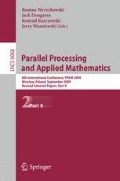Abstract
The individuation of areas that are more likely to be interested by lava eruptions is of fundamental relevance for mitigating possible consequences, both in terms of loss of human lives and material properties. Here we show a methodology for defining flexible high-detailed lava invasion susceptibility maps. It relies on both an adequate knowledge of the volcano, assessed by an accurate analysis of its past behaviour, a reliable Cellular Automata model for simulating lava flows on present topographic data and on High Performance Parallel Computing for increasing computational efficiency. The application of the methodology to the case of Mt Etna, the most active volcano in Europe, points out its usefulness in land use planning and Civil Defence applications.
Access this chapter
Tax calculation will be finalised at checkout
Purchases are for personal use only
Preview
Unable to display preview. Download preview PDF.
References
Behncke, B., Neri, M., Nagay, A.: Lava flow hazard at Mount Etna (Italy): New data from a GIS-based study. Spec. Pap. Geol. Soc. Am. 396, 187–205 (2005)
Chester, D.K., Duncan, A.M., Dibben, C., Guest, J.E., Lister, P.H.: Mascali, Mount Etna Region Sicily: An Example of Fascist Planning During the 1928 Eruption and Its Continuing Legacy. Nat. Hazards 19, 29–46 (1999)
Barberi, F., Brondi, F., Carapezza, M.L., Cavarra, L., Murgia, C.: Earthen barriers to control lava flows in the 2001 eruption of Mt. Etna. J. Volcanol. Geotherm. Res. 123, 231–243 (2003)
Ishihara, K., Iguchi, M., Kamo, K.: Lava flows and domes: emplacement mechanisms and hazard implications. In: IAVCEI Proceedings, pp. 174–207. Springer, Heidelberg (1990)
Del Negro, C., Fortuna, L., Herault, A., Vicari, A.: Simulations of the 2004 lava flow at Etna volcano using the magflow cellular automata model. Bull. Volcanol. 70, 805–812 (2008)
Crisci, G., Rongo, R., Di Gregorio, S., Spataro, W.: The simulation model SCIARA: the 1991 and 2001 lava flows at Mount Etna. J. Volcanol. Geotherm. Res. 132, 253–267 (2004)
McBirney, A.R., Murase, T.: Rheological properties of 731 magmas. Annu. Rev. Earth Planet. Sci. 12, 337–357 (1984)
Von Neumann, J.: Theory of self reproducing automata. Univ. Illinois Press, Urbana (1966)
Chopard, B., Droz, M.: Cellular Automata Modeling of Physical Systems. Cambridge University Press, Cambridge (1998)
Succi, S.: The Lattice Boltzmann Equation for Fluid Dynamics and Beyond. Oxford University Press, Oxford (2004)
Di Gregorio, S., Festa, D., Rongo, R., Spataro, W., Spezzano, G., Talia, D.: A microscopic freeway traffic simulator on a highly parallel system. In: D’Hollander, F.P.E.H., Joubert, G.R., Trystam, D. (eds.) Parallel Computing: State-of-the-Art and Perspectives, pp. 69–76 (1996)
Rosin, P.L.: Training Cellular Automata for Image Processing. IEEE Trans. on Image Process. 15(7), 2076–2087 (2006)
Tomassini, M., Perrenoud, M.: Cryptography with cellular automata. Appl. Soft Comput. 1(2), 151–160 (2001)
Page, S.: On Incentives and Updating in Agent Based Models. Comput. Econ. 10(1), 67–87 (1997)
Crisci, G.M., Di Gregorio, S., Ranieri, G.: A cellular space model of basaltic lava flow. In: Proceedings Int. Conf. Applied Modelling and Simulation 82, Paris-France, vol. 11, pp. 65–67 (1982)
Di Gregorio, S., Serra, R.: An empirical method for modelling and simulating some complex macroscopic phenomena by cellular automata. Fut. Gener. Comp. Syst. 16, 259–271 (1999)
Rongo, R., Spataro, W., D’Ambrosio, D., Avolio, M.V., Trunfio, G.A., Di Gregorio, S.: Lava flow hazard evaluation through cellular automata and genetic algorithms: an application to Mt. Etna. volcano. Fund. Inform. 8, 247–268 (2008)
Crisci, G.M., Iovine, G., Di Gregorio, S., Lupiano, V.: Lava-flow hazard on the SE flank of Mt. Etna. (Southern Italy). J. Volcanol. Geotherm. Res. 177(4), 778–796 (2008)
Author information
Authors and Affiliations
Editor information
Editors and Affiliations
Rights and permissions
Copyright information
© 2010 Springer-Verlag Berlin Heidelberg
About this paper
Cite this paper
Avolio, M.V., D’Ambrosio, D., Lupiano, V., Rongo, R., Spataro, W. (2010). Evaluating Lava Flow Hazard at Mount Etna (Italy) by a Cellular Automata Based Methodology. In: Wyrzykowski, R., Dongarra, J., Karczewski, K., Wasniewski, J. (eds) Parallel Processing and Applied Mathematics. PPAM 2009. Lecture Notes in Computer Science, vol 6068. Springer, Berlin, Heidelberg. https://doi.org/10.1007/978-3-642-14403-5_52
Download citation
DOI: https://doi.org/10.1007/978-3-642-14403-5_52
Publisher Name: Springer, Berlin, Heidelberg
Print ISBN: 978-3-642-14402-8
Online ISBN: 978-3-642-14403-5
eBook Packages: Computer ScienceComputer Science (R0)

